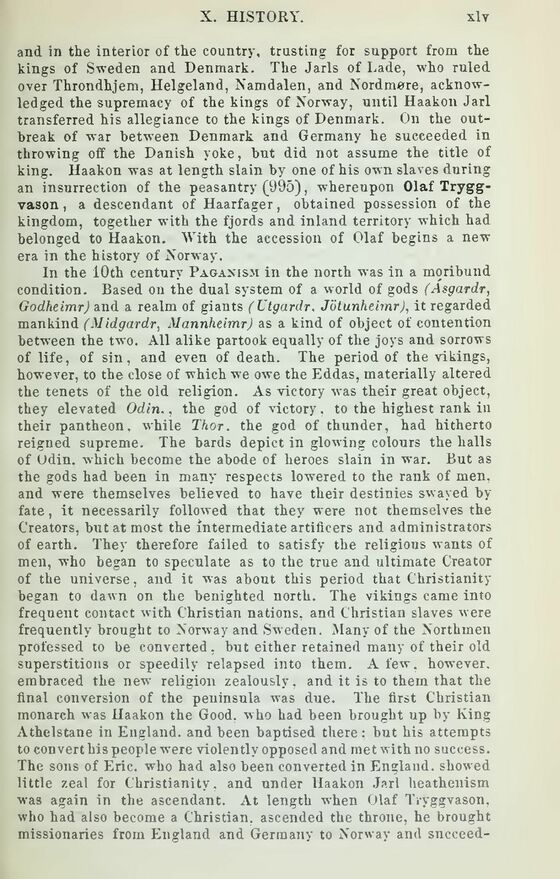
Full resolution (JPEG) - On this page / på denna sida - Introduction - Pages ...

<< prev. page << föreg. sida << >> nästa sida >> next page >>
Below is the raw OCR text
from the above scanned image.
Do you see an error? Proofread the page now!
Här nedan syns maskintolkade texten från faksimilbilden ovan.
Ser du något fel? Korrekturläs sidan nu!
This page has never been proofread. / Denna sida har aldrig korrekturlästs.
and in the interior of the country, trusting for snpport from the
kings of Sweden and Denmark. The Jarls of Lade, who ruled
over Throndhjem, Helgeland, Namdalen, and Nordmøre,
acknowledged the supremacy of the kings of Norway, until Haakon Jarl
transferred his allegiance to the kings of Denmark. On the
outbreak of war between Denmark and Germany he succeeded in
throwing off the Danish yoke, but did not assume the title of
king. Haakon was at length slain by one of his own slaves during
an insurrection of the peasantry (995), whereupon Olaf
Trygg-vason, a descendant of Haarfager, obtained possession of the
kingdom, together with the fjords and inland territory which had
belonged to Haakon. With the accession of Olaf begins a new
era in the history of Norway.
In the 10th century Paganism in the north was in a moribund
condition. Based on the dual system of a world of gods (Asgardr,
Godheimr) and a realm of giants (L’tgardr. Jötunhehnr), it regarded
mankind (Midgardr, Mannheimr) as a kind of object of contention
between the two. All alike partook equally of the joys and sorrows
of life, of sin, and even of death. The period of the vikings,
however, to the close of which we owe the Eddas, materially altered
the tenets of the old religion. As victory was their great object,
they elevated Odin., the god of victory, to the highest rank in
their pantheon, while Thor, the god of thunder, had hitherto
reigned supreme. The bards depict in glowing colours the halls
of Udin. which become the abode of heroes slain in war. But as
the gods had been in many respects lowered to the rank of men,
and were themselves believed to have their destinies swayed by
fate, it necessarily followed that they were not themselves the
Creators, but at most the intermediate artificers and administrators
of earth. They therefore failed to satisfy the religious wants of
men, who began to speculate as to the true and ultimate Creator
of the universe, and it was about this period that Christianity
began to dawn on the benighted north. The vikings came into
frequent contact with Christian nations, and Christian slaves were
frequently brought to Norway and Sweden. Many of the Northmen
professed to be converted. but either retained many of their old
superstitions or speedily relapsed into them. A few. however,
embraced the new religion zealously, and it is to them that the
final conversion of the peninsula was due. The first Christian
monarch was Haakon the Good, who had been brought up by King
Athelstane in England, and been baptised there : but his attempts
to convert his people were violently opposed and met with no success.
The sons of Eric, who had also been converted in England, showed
little zeal for Christianity, and under Haakon Jarl heathenism
was again in the ascendant. At length when Olaf Tryggvason,
who had also become a Christian, ascended the throne, he brought
missionaries from England and Germany to Norway and succeed-
<< prev. page << föreg. sida << >> nästa sida >> next page >>